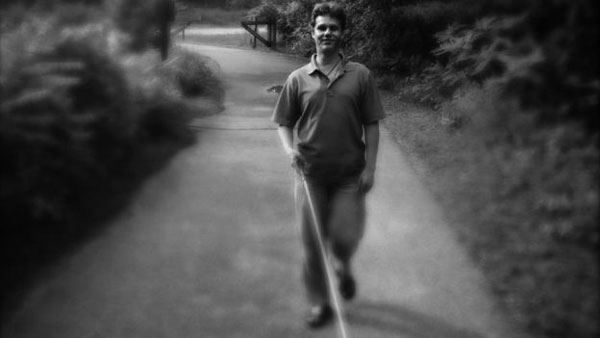[ad_1]
A study has revealed secrets that help some blind people navigate their world by “seeing with sound”.
 |
|
Daniel Kish says echolocation is like “opening one’s eyes” — Photo: OTHER
|
People who use “echolocation” employ it in a very similar way to bats – producing clicks that bounce off objects and “sonify” them into a picture of the surroundings.
A study of experts in the technique has revealed how louder clicks allow “echolocators” to see behind them.
The insights are published in the Royal Society journal Proceedings B.
The key finding was that – just like bats – expert echolocators instinctively increase the intensity (or loudness) of their clicks, and click more frequently when an object is off to the side or behind them.
“Everyone’s clicks are different,” explained Daniel Kish, a co-author on this study, who is also a blind expert in echolocation and already teaches it to others.
“I click using my tongue against the roof of my mouth – it’s an implosive, sharp sound. It can penetrate the background noise and bring information to you from dozens or hundreds of metres away.”
Recent research has shown that echolocation can provide detail about objects in the environment, including shape, size, distance, and even the material they are made from.
Human sonar
Dr Lore Thaler, the neuroscientist from Durham University, who led the study, said that revealing how experts fine-tune their technique could help develop methods of teaching it to others.
Dr Thaler and her colleagues used a special sound-deadening room to put echolocating volunteers to the test. Eight participants stood in this soft, foam-lined room with their fingers in their ears humming a tune, while one of the scientists placed an echo-producing disc somewhere around them.
“We’d then retreat behind them and we would use a long stick to tap them gently on the back of their foot. Then, they would stop humming, unblock their ears and start making mouth clicks and using the echoes to tell us – was there a target present or not?”
This revealed that echolocators could spot the target in front of them after a click or two. But if it was off to the side or behind them, they needed about 10 or 12 clicks, and the clicks became much louder.
Lore Thaler: “Click energy is very much to the front of the person, with very little going to the back. So I think people are compensating, or double-checking by sending more sound behind them.”
Daniel Kish described its impact of echolocation on the life of a blind person as “a bit like opening one’s eyes”.
“You can imagine it as the difference between going through the world with your eyes half-closed versus open,” he told BBC News.
“And the more we understand it, the more we can develop effective methods for teaching and for learning it.”
Super-senses?
The researchers also recorded the echoes that each object reflected back to each participant – using microphones placed by each volunteer’s ear.
“They were able to detect echoes up to 95% softer than the initial click,” said Dr Thaler. “So they adapt extraordinarily. The next question is – if we train people, how does their sensitivity develop?”
Dr Andrew Kolarik from the University of Cambridge has also studied echolocation extensively and said the study illustrated how people adapted their clicks to get the best information they could from their surroundings.
“Each echolocation click is like a single snapshot of the world,” Dr Kolarik told BBC News.
“[The technique] can also be very useful at providing information at face or chest height, to avoid objects like low handing branches that might not get detected by the white cane or a guide dog.
“So teaching echolocation skills could provide blind people with the means of exploring new places [through sound].”
Source: BBC
[ad_2]
Source link
